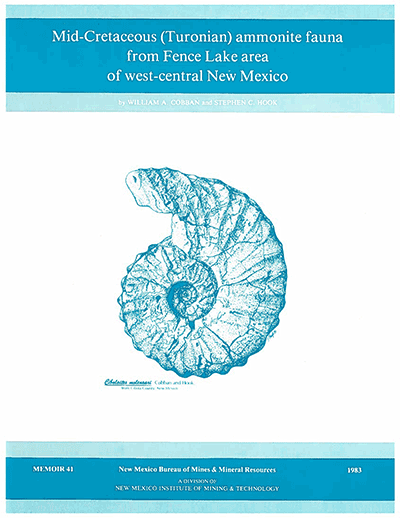
Memoir 41—Mid-Cretaceous (Turonian) ammonite fauna from Fence Lake area of west-central New Mexico
By W. A. Cobban and S. C. Hook, 1983, 50 pp., 1 table, 14 figs., 14 plates, 1 index.

Describes an early Turonian ammonite fauna found chiefly in Cibola County, New Mexico, consisting of nine genera and 10 species of which two genera and two species are new. The genera are: Baculites, Tragodesmoceras, Placenticeras, Mammites, Morrowites (new), Kamerunoceras, Neoptychites, Fagesia, and Cibolaites (new). Species known elsewhere in the world, but recorded for the first time in North America, are Kamerunoceras turoniense (d'Orbigny) and Fagesia superstes (Kossmat). Mammites nodosoides dates the fauna as early Turonian, and the presence of Collignoniceras woollgari just above the level of the Fence Lake fauna suggests a high position in the early Turonian.
Molluscan fossils of early Turonian age were discovered in 1972 near the top of the Mancos Shale in the Fence Lake area approximately 105 km (65 mi) south of Gallup, New Mexico. That the locality was unusual in having an abundant warm water or Tethyan ammonite fauna became apparent, and many collecting trips were made later by the authors as well as by other members of the United States Geological Survey and the New Mexico Bureau of Mines and Mineral Resources. The collections are of much interest in that they contain two new genera of ammonites as well as two species known from Europe and Africa but previously not recorded from North America. The specimens described or illustrated in this report are kept in the National Museum of Natural History, Washington, D. C., and have USNM catalog numbers.
Species of fossil molluscs in the Fence Lake area are chiefly bivalves and ammonites. Although gastropods are locally abundant, species diversity is very low. Inasmuch as most of the collecting was carried out in an arroyo on the south side of Jaralosa Canyon, 7 mi northwest of Fence Lake. Of the fossils listed in this report, Solemya, Pholadomya, Dentalium, Pyropsis, and Fagesia are represented each by a single specimen at this locality. Phelopteria, Pleuriocardia, Cymbophora, Tragodesmoceras, and Kamerunoceras are represented by only two or three specimens each. The bivalve and gastropod record is biased, however, because the fossil collecting was carried on primarily for ammonites.
Most fossils occur in argillaceous limestone concretions that weather yellowish-gray to olive-gray or brown. The concretions may form well-defined beds, or they may occur scattered throughout a shale unit. Size of the concretions ranges from an inch or two in length to several feet. Many of the concretions, especially the larger ones, are septarian with dark- to medium-brown calcite veins. The larger concretions may have, in addition to the calcite, white barite. Fossils may occur throughout the concretions and often protrude from them. Oysters and other molluscs that had original calcitic shells are very well preserved, and an occasional oyster has radial color bands. Other molluscs, such as ammonites and gastropods that had aragonitic shells, have poorly preserved shell material, and many specimens are internal molds. Epizoans, usually oysters, encrust some of the larger ammonites, especially Morrowites.
Many concretions contain numerous specimens representing a single species. The gastropod Turritella whitei Stanton and the bivalve Veniella mortoni often occur in this manner. Other concretions may contain only the bivalve Mytiloides mytiloides or an oyster that resembles Curvostrea rediviva. One concretion had more than 30 specimens of the ammonite Baculites yokoyamai Tokunaga and Shimizu. Aside from molluscs, other fossils are scarce in the concretions. Pieces of fossilized wood much bored by bivalves occur here and there. Fish and anthropod remains are extremely rare. Part of a small fish in one concretion has its scales in place.
The fossil molluscs described in this report came from the Rio Salado Tongue of the Mancos Shale, which in the Fence Lake area, is overlain by a cliff-forming unit- the Artarque Sandstone. Several stratigraphic sections were measured through the Rio Salado. A section measured on the Atarque Lake 7½-min quadrangle northwest of Fence Lake is presented here as representative of the Rio Salado and it ammonite sequence. This section is approximately 16 mi north-northwest of columnar section 36 of Molenaar.
$10.00
Buy
Now
Also available as a free download.
Download
| File Name | Size | Last Modified |
|---|---|---|
| Memior_41.pdf | 2.20 MB | 01/19/2021 10:02:51 AM |



